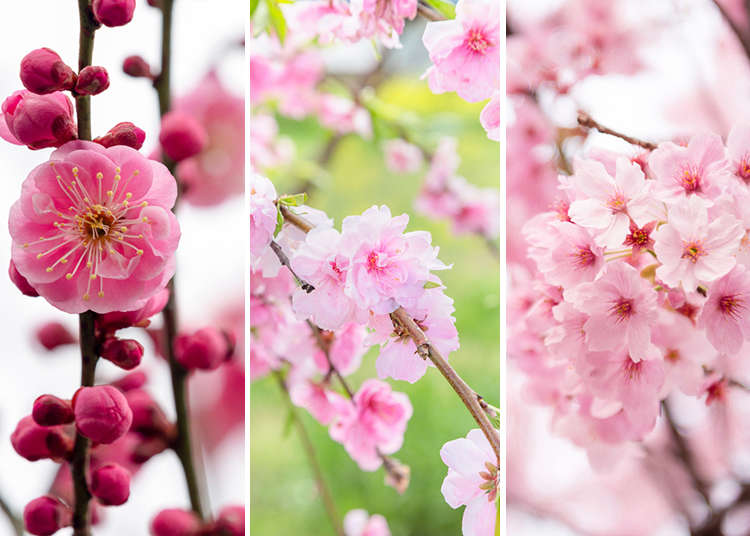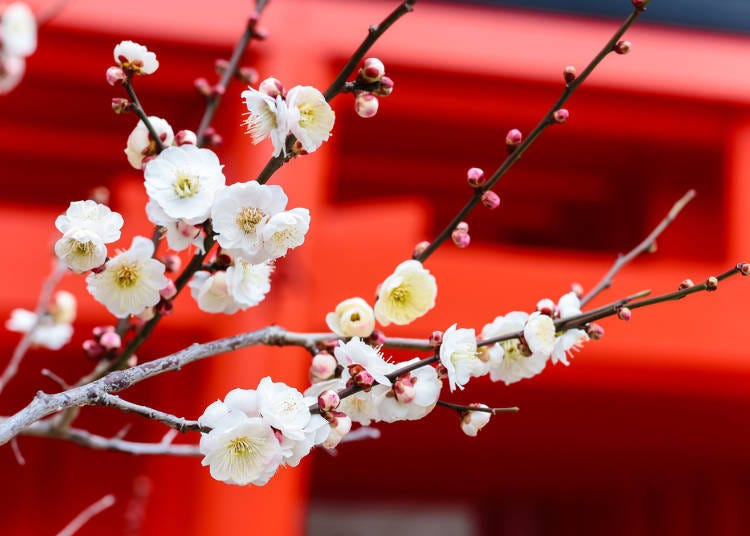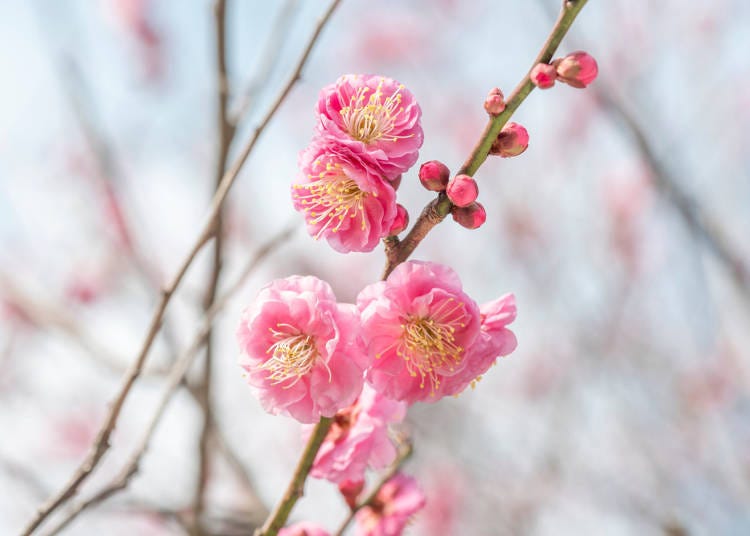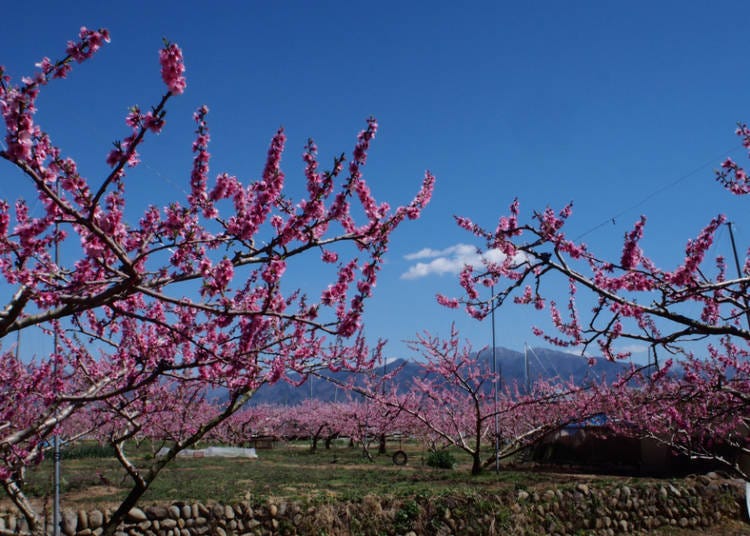
What is the Difference Between Plum and Cherry Blossom? How To Tell Them Apart & 7 Places to See Them
- Written by: WESTPLAN
In Japan, you'll see pretty flowers begin to bloom around February, in the midst of the cold of winter. Depending on the season, they could be either plum, peach, or cherry blossoms.
However, it can be hard to tell which is which at first glance, even for Japanese people! Here, we will share how to tell these three flowers apart so you can fully experience the changing of the seasons.
- Table of Contents
-
- 1. Plum, peach, and cherry blossoms are important parts of Japanese culture!
- 2. How to Distinguish Between Plum, Peach, and Cherry Blossoms
- 3. How Japanese Enjoy Plum, Peach, and Cherry Blossoms
- 4. Recommended Spots to See Plum Blossoms in Full Bloom
- 5. Famous Peach Blossom Spots! Gorgeous Shades of Pink
- 6. Must-See, Famous Cherry Blossom Spots with Fantastic Views
1. Plum, peach, and cherry blossoms are important parts of Japanese culture!

Plum, peach (ornamental varieties of peach flowers), and cherry blossoms belong to the Rosales, Rosaceae, and Prunus genus, whose differences can be difficult to tell apart. All three are part of the same category, so it's no wonder they look so similar!

In Japan, plum blossoms are an auspicious flower that heralds the arrival of spring. It is also popularly used as a design for New Year's greeting cards. The kanji character for plum is found in the names of places and people, is drawn on family crests, and is even seen in the traditional card game, karuta, as "hanafuda" (花札) cards.

Peach blossoms have long been regarded as an amulet of longevity.
Hinamatsuri (Doll Festival), a Japanese holiday on March 3rd that celebrates young girls and prays for their health, is also sometimes called the "Peach Festival". It is said to have originated from the Chinese holiday, Joshi no Sekku (Girls' Festival), which also celebrates with peach blossoms.

The sakura, or cherry blossom, is the representative flower of spring in Japan. This flower also heralds the approaching rice planting season. In modern times, this flower also represents a bright season of a new semester and a new school year. Going to hanami, or cherry blossom viewing, has become a seasonal tradition.

2. How to Distinguish Between Plum, Peach, and Cherry Blossoms
It can be difficult to tell plum blossoms, peach blossoms, and cherry blossoms apart, even when looking at them side-by-side. Here are some key points to help you distinguish them.
i. Differences between flower shapes, branches, and trunks
In general, each flower has five individual petals, so you won't be able to tell them apart by counting them. However, as seen in the illustration below, you can look at the shape of the petals and note how the flowers are attached to the branches.

ii. Differences between colors and scents
Plum: Flower colors can be broadly divided into white and crimson, though complex color differences can occur between them. For example, some buds turn pink when they bloom, and some buds turn white. Some buds have a pale pistil, and only the petals are red. They have a sweet, gentle scent similar to jasmine.
Peach: Flowers can be white, pink, or red. The color varies by type and individual plant. Different colored flowers might even grow on one tree! The scent is sweet and mild, which you can smell from both the flowers and the leaves.
Cherry Blossom: Can be white, light pink, or dark pink, depending on the type and individual plant. The cherry blossom scent is usually very mild, and Yoshino cherry trees are particularly faint, barely noticeable even if you bring your nose close. While there are more fragrant varieties with stronger scents, you won't usually see them around town.

Plum, peach, and cherry blossoms come in a wide range of shades of very similar colors, so it may not be enough to judge them by color alone. The flower scents are all different, however, so it may help if you get closer.
iii. Difference in flowering times
Plum, peach, and cherry blossoms, which are said to be the most common amongst the many varieties, bloom in a specific order every year.
In Kyushu, plum blossoms usually bloom in January, peach blossoms in early March, and cherry blossoms in mid-March. The blooming of cherry and peach blossoms may overlap in some areas.
・Plums bloom from late January to late April.
・Peaches bloom from early March to late April.
・In the Japanese archipelago, cherry blossoms bloom from southwest to northeast from mid-March to late April. (Times may vary each year.)

3. How Japanese Enjoy Plum, Peach, and Cherry Blossoms
Here are some ways that Japanese people celebrate these three different flowers that signal the start of spring.

Plum: While you can certainly enjoy the flowers blooming in your own family's garden, you may want to check out the appreciation party held at Bai-en (a garden with many plum trees).
Because it is held during the cold season, you'll also be able to enjoy a wonderful tea ceremony with matcha and amazake as you take in the plum blossoms.

Peach: These flowers are popularly sold and displayed at flower shops both before and after Hinamatsuri on March 3rd. Decorate your home or workplace with these flowers to celebrate Hinamatsuri and welcome the spring.
Some parks and mountains with many peach trees also hold a Hanamomo (Peach Tree) Festival.

Cherry Blossom: Hanami, or "cherry blossom viewing," is a popular custom in Japan when cherry blossom trees are in full bloom.
Hanami events have become a part of the general public since the Edo Period, nearly 400 years ago. The fun of Hanami comes from enjoying a picnic and drinks under the cherry trees with your friends!
(Many cherry blossom events have been canceled since 2020 due to covid, though you may still be able to view them in smaller groups for shorter periods of time.)
4. Recommended Spots to See Plum Blossoms in Full Bloom
There are many spots in Japan where you can see plum trees of all sizes. Here are two famous plum-viewing spots.
i. Kairakuen (Ibaraki Prefecture)

Kairakuen, located in Mito, Ibaraki Prefecture, is one of Japan's three most famous gardens, along with Kenrokuen in Kanazawa and Korakuen in Okayama. In 1842, Tokugawa Nariaki, the feudal lord of his time, built Kairakuen with plums he collected and planted himself.
Today, there are nearly 3,000 plum trees of 100 varieties. Because there is a mix of early-, medium-, and late-blooming types, you'll see flowers blooming here for a longer period of time.
・Annual flowering time: January to March
-
Kairakuen偕楽園
- Address 1-Chome-3-3 Tokiwacho, Mito-shi, Ibaraki 310-0033
-
Nearest Station
15 minutes from the north exit of JR Mito Station by bus bound for Kairakuen-mae.
- Phone Number 029-244-5454
Open: Mid-February - September 30 6:00 - 19:00
* October 1 to mid-February 7:00 to 18:00
Closed: Open daily
Admission: Adults 300yen, Elementary and junior high school students 150yen (Tax included)
ii. Osaka Castle Park (Osaka)

This central Osaka venue boasts a beautiful plum blossom view with Osaka Castle in the background! The plum grove boasts an area of about 17,000 square meters, with nearly 1,270 plum trees of 100 varieties in bloom. It is also a popular photo spot for snapshots of the trees with the castle in the background. Since the types of plum blossoms vary, from early- to late-bloomers, you can see plum blossoms here for a long time.
・Annual flowering time: January-March
-

-
Address
Osakajo, Chuo-ku, Osaka-shi, Osaka, 540-0002
View Map -
Nearest Station
Osakajokoen Station (JR Osaka Loop Line)
- Phone Number 06-6755-4146
-
Address
Osakajo, Chuo-ku, Osaka-shi, Osaka, 540-0002
5. Famous Peach Blossom Spots! Gorgeous Shades of Pink
Vast areas filled with beautiful Hanamomo peach trees. Introducing two scenic spots of the Peach Blossom Paradise known as Togenkyo.
i. Shimpu Togenkyo (Yamanashi Prefecture)

Shimpu Togenkyo is a vast land of about 60 hectares in Nirasaki City, Yamanashi Prefecture, a peach field where edible peaches (rather than the ornamental variety) are cultivated. Yamanashi's flowering time is rather late, around mid-April, when you'll see the peach blossoms against the snowy mountains of the Minami-Alps. You can also see a great view of Mt. Fuji and the Yatsugatake volcanoes.
・Annual Flowering Time: mid-late April
-
Shimpu Togenkyo新府桃源郷
- Address 3511 Nakajo, Nakadamachi, Nirasaki-shi, Yamanashi 407-0262
-
Nearest Station
15-minute walk from Shimpu Station on the JR Chuo Main Line
Phone: 0551-22-1111 (Nirasaki City Tourism Association, 9:00AM-5:00PM *Lunch break: 12:00M-1:00PM; November 1-March 30 Hours: until 4:00PM; December 28: until 1:00PM; Closed March 3)
ii. Kinokawa River Togenkyo (Wakayama Prefecture)

Momoyama-cho, located in Kinokawa City, Wakayama Prefecture, is the production site of luxury peach brand, Arakawa no Momo. The blooming flowers of the peach field dye the entire south side of the Kinokawa River in pink. This area is called Togenkyo, where you can see as many as 100,000 peach trees in a single glance!
・Annual flowering time: late March to early April
-
Togenkyo桃源郷
- Address Momoyamacho, Kinokawa-shi, Wakayama
-
Nearest Station
20-minute walk from Shimo-Isaka Station on the JR Wakayama Line
Phone: 0736-66-1259 (Arakawa no Momo Promotion Council: Mon-Fri 9:00AM-5:00PM)
Vacancy search, reservation
-
from 14,727JPY 1room, 2adults
Check with our partner site as the latest rates, rate details, and guest room requirements may vary.
6. Must-See, Famous Cherry Blossom Spots with Fantastic Views
There are countless cherry blossom spots in Japan. Here are three of the most famous with the best views.
i. Hirosaki Park (Aomori Prefecture)

There are about 2,600 cherry trees of 52 species in Hirosaki Park, located in Hirosaki City, Aomori Prefecture, including weeping and yae-sakura cherry trees. There are also over 400 Yoshino cherry trees that are over 100 years old. This spot has been selected as one of the 100 Best Cherry Blossom Spots in Japan. It is famous for its beautiful view of Hirosaki Castle surrounded by cherry blossoms, as well as the Hanaikada, where fallen cherry blossom petals carpet the surface of the outer moat in stunning hues of pink.
・Best time to see: Late April to early May
-

-
Address
1, Shimoshiroganecho, Hirosaki-shi, Aomori, 036-8256
View Map -
Nearest Station
Chuohirosaki Station (Konan Tetsudo-owani Line)
15 minutes by car
- Phone Number 0172-33-8739
-
Address
1, Shimoshiroganecho, Hirosaki-shi, Aomori, 036-8256
ii. Chidorigafuchi Moat (Tokyo)

Along the Chidorigafuchi Moat, a promenade on the west side of the Imperial Palace, lies a 700-meter-long tunnel of blooming cherry blossom trees. The water's surface is also dyed in a beautiful shade of light pink by the Yoshino cherry trees.
・Best time to see: Late March to early April
-

-
Address
2, Kudanminami, Chiyoda-ku, Tokyo, 102-0083
View Map -
Nearest Station
Hanzomon Station (Tokyo Metro Hanzomon Line)
5 minutes on foot
- Phone Number 03-3556-0391
-
Address
2, Kudanminami, Chiyoda-ku, Tokyo, 102-0083
iii. Mount Yoshino (Nakasenbon/Nara Prefecture)

Approximately 30,000 cherry trees, including wild cherry blossoms, bloom in four spots: bottom, middle, top, and back. There are about 200 kinds of wild cherry blossoms, which paint the entire mountain in shades of white, pink, and crimson.
・Best time to see: Early to mid-April
-

-
Address
Yoshinoyama, Yoshino-cho, Yoshino-gun, Nara, 639-3115
View Map -
Nearest Station
Yoshino Station (Kintetsu-yoshino Line)
- Phone Number 0746-39-9237
-
Address
Yoshinoyama, Yoshino-cho, Yoshino-gun, Nara, 639-3115
From January to April, plum, peach, and cherry blossoms bloom all over Japan. These flowers have been long admired by Japanese people, and you will find them planted in various places.
By learning the differences between the three, not only will you be able to recognize each flower when you see them, but you may also experience a deeper appreciation for the season of spring.
Plum, Peach and Cherry Blossom Supervisor: Hanshin Gardening Co.
*Cherry blossom flowering times vary each year.
*Event dates and activities subject to change. Please be sure to avoid crowds and take proper precautions against infection when going out.
Kiko Matsuda, Keiko Kimura, Risa Tsushi, and a team of female writers familiar with Kansai. We love eating, drinking and traveling! We share fun information based on our experiences.
*Prices and options mentioned are subject to change.
*Unless stated otherwise, all prices include tax.
Popular Tours & Activitiess
Recommended places for you
-

Kanzenkoshitsuyakinikutabehodai Gyugyu Paradise Sannomiya
Yakiniku
Kobe, Sannomiya, Kitano
-

Kambei Sannomiyahonten
Yakiniku
Kobe, Sannomiya, Kitano
-

ISHIDAYA Hanare
Yakiniku
Kobe, Sannomiya, Kitano
-
Goods

Yoshida Gennojo-Roho Kyoto Buddhist Altars
Gift Shops
Nijo Castle, Kyoto Imperial Palace
-
Appealing

Rukku and Uohei
Izakaya
Sapporo / Chitose
-

Jukuseiniku-to Namamottsuarera Nikubaru Italian Nikutaria Sannomiya
Izakaya
Kobe, Sannomiya, Kitano
-

Jujutsu Kaisen Takes Over JR East With a Wrapped Shinkansen This Winter
by: Guest Contributor
-
Ad

Discover the "Miraculous Forest" in the Heart of Tokyo: The Institute for Nature Study (9 Minutes from JR Meguro Station)
-

How to Get Don Quijote's Exclusive 2025-2026 Winter Gift (+Tax-Free Savings)
-
Ad

Preserving the Beauty of World Heritage Site Shirakawa-go for the Future Through Responsible Travel
-

First Japan Cherry Blossom 2026 Forecast Announced! Here's When & Where to See Sakura in Japan
-

Japan’s Shinkansen Is About to Change Travel in an Unexpected Way
by: Guest Contributor
-

Michelin Star Restaurants & More: 3 Best Okonomiyaki Shops in Dotonbori Osaka
-

5 Must-Visit Nara Temples and Shrines: Discover the Timeless Beauty of Japan's Ancient Capital
by: WESTPLAN
-

Exploring Tokyo's Neighborhoods: Enjoy Japan's Capital City in Your Own Style
by: Yoko
-

Guide to 7 Popular Niseko Ski Rental Shops With Covid-19 Countermeasures
-

Meiji Shrine (Meiji Jingu): Exploring the Sacred Sanctuary of Peace in Bustling Tokyo
-

6 Surprisingly Cheap Things in Japan
- #best sushi japan
- #what to do in odaiba
- #what to bring to japan
- #new years in tokyo
- #best ramen japan
- #what to buy in ameyoko
- #japanese nail trends
- #things to do japan
- #onsen tattoo friendly tokyo
- #daiso
- #best coffee japan
- #best japanese soft drinks
- #best yakiniku japan
- #japanese fashion culture
- #japanese convenience store snacks















